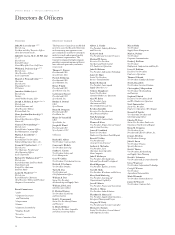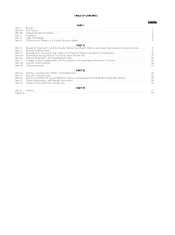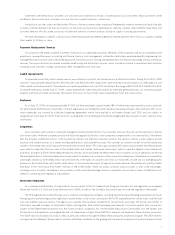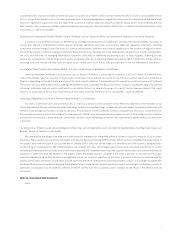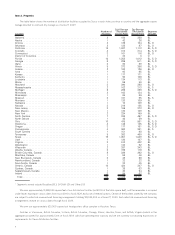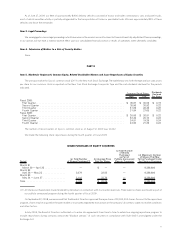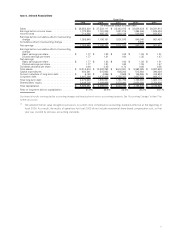Sysco 2009 Annual Report Download - page 23
Download and view the complete annual report
Please find page 23 of the 2009 Sysco annual report below. You can navigate through the pages in the report by either clicking on the pages listed below, or by using the keyword search tool below to find specific information within the annual report.Credit terms we extend to our customers can vary from cash on delivery to 30 days or more based on our assessment of each customer’s credit
worthiness. We monitor each customer’s account and will suspend shipments if necessary.
A majority of our sales orders are filled within 24 hours of when customer orders are placed.We generally maintain inventory on hand to be able
to meet customer demand. The level of inventory on hand will vary by product depending on shelf-life, supplier order fulfillment lead times and
customer demand. We also make purchases of additional volumes of certain products based on supply or pricing opportunities.
We take advantage of suppliers’ cash discounts where appropriate and otherwise generally receive payment terms from our suppliers ranging
from weekly to 30 days or more.
Corporate Headquarters’ Services
Our corporate staff makes available a number of services to our operating companies. Members of the corporate staff possess experience and
expertise in, among other areas, accounting and finance, treasury, cash management, information technology, employee benefits, engineering, risk
management and insurance, sales and marketing, payroll, human resources, training and development, information technology and tax compliance
services. The corporate office also makes available warehousing and distribution services, which provide assistance in operational best practices
including space utilization, energy conservation, fleet management and work flow.
Capital Improvements
To maximize productivity and customer service, we continue to construct and modernize our distribution facilities. During fiscal 2009, 2008
and 2007, approximately $464,561,000, $515,963,000 and $603,242,000 respectively, were invested in facility expansions, fleet additions and
other capital asset enhancements. We estimate our capital expenditures in fiscal 2010 should be in the range of $600,000,000 to $650,000,000.
During the three years ended June 27, 2009, capital expenditures were financed primarily by internally generated funds, our commercial paper
program and bank and other borrowings. We expect to finance our fiscal 2010 capital expenditures from the same sources.
Employees
As of June 27, 2009, we had approximately 47,000 full-time employees, approximately 18% of whom were represented by unions, primarily
the International Brotherhood of Teamsters. Contract negotiations are handled by each individual operating company. Approximately 23% of our
union employees are covered by collective bargaining agreements which have expired or will expire during fiscal 2010 and are subject to
renegotiation. Since June 27, 2009, three contracts covering 440 of such employees have been renegotiated. We consider our labor relations to be
satisfactory.
Competition
Sysco competes with numerous companies engaged in foodservice distribution. Our customers may also choose to purchase products directly
from retail outlets. While we compete primarily with local and regional distributors, a few companies compete with us on a national basis. We believe
that the principal competitive factors in the foodservice industry are effective customer contacts, the ability to deliver a wide range of quality
products and related services on a timely and dependable basis and competitive prices. We consider our primary market to be the foodservice
market in the United States and Canada and estimate that we serve about 17% of this approximately $215 billion annual market. We believe, based
upon industry trade data, that our sales to the United States and Canada “food-away-from-home” industry were the highest of any foodservice
distributor during fiscal 2009. While adequate industry statistics are not available, we believe that in most instances our local operations are among
the leading distributors of food and related non-food products to foodservice customers in their respective trading areas. We believe our competitive
advantages include our diversified product base, the diversity in the types of customers we serve, our economies of scale and our wide geographic
presence in the United States and Canada, which allows us to minimize the impact of regional economic declines. We are the only publicly-traded
distributor in the “food-away-from-home” industry in the United States. While our public company status provides us with some advantages,
including access to capital, we believe it also provides us with some disadvantages that our competitors do not have in terms of additional costs
related to complying with regulatory requirements.
Government Regulation
As a marketer and distributor of food products, we are subject to the U.S. Federal Food, Drug and Cosmetic Act and regulations promulgated
thereunder by the U.S. Food and Drug Administration (FDA), as well as the Canadian Food and Drugs Act and the regulations thereunder.
The FDA regulates food safety through various statutory and regulatory mandates, including manufacturing and holding requirements for foods
through good manufacturing practice regulations, hazard analysis and critical control point (HACCP) requirements for certain foods, and the food
and color additive approval process. The agency also specifies the standards of identity for certain foods, prescribes the format and content of
information required to appear on food product labels, and regulates food contact packaging and materials. For certain product lines, we are also
subject to the Federal Meat Inspection Act, the Poultry Products Inspection Act, the Perishable Agricultural Commodities Act, the Packers and
Stockyard Act and regulations promulgated by the U.S. Department of Agriculture (USDA) to interpret and implement these statutory provisions.
The USDA imposes standards for product safety, quality and sanitation through the federal meat and poultry inspection program.The USDA reviews
and approves the labeling of these products and also establishes standards for the grading and commercial acceptance of produce shipments from
3



